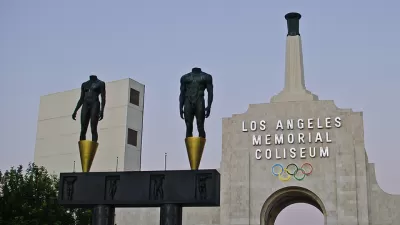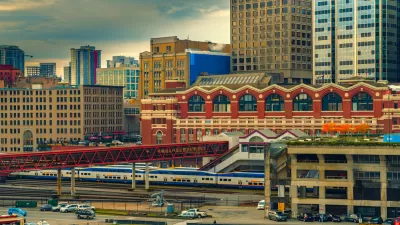The 2010 Vancouver Winter Olympics and Paralympics are over now. City Planner Brent Toderian described in a recent Planetizen blog how the event showcased Vancouver’s Urbanism, including the quality of its neighborhoods, streets and public transit system, and the delight of a shared community experience.
The 2010 Vancouver Winter Olympics and Paralympics are over now. City Planner Brent Toderian described in a recent Planetizen blog how the event showcased Vancouver's Urbanism, including the quality of its neighborhoods, streets and public transit system, and the delight of a shared community experience.

There are other important lessons for planners from this event. Let me share some observations about the Olympic Transportation Plan. Overall, it was successful. With just a few exceptions, everybody got where they needed to go on time, with reasonable comfort. This success resulted from excellent planning by many people representing various organizations: Olympic committees, cities, regional agencies, provincial and federal governments, and various service providers.
Let me share some thoughts based on my experience having helped in a small way develop the plan. It was a very fun planning exercise. Basically, this was a huge party attracting many honored guests. Our job was to insure it went smoothly and everybody had a great time. This is logistical science at its best. We needed to insure that tens of thousands of people could travel reliably between numerous diverse venues, including about 30,000 people from Vancouver up to Whistler and back every day for more than two weeks. We had tremendous resources available: if it required six hundred extra buses with 1,800 extra drivers, or total control of a highway or traffic lanes, we got them.
Oh, did I mention that this all takes place during the middle of winter, and much of the travel involves mountain roads? Did I mention that schedules were subject to change at any time due to weather or other unexpected events? And did I mention that security trumps everything else, so each component of the plan needed security review?
No problem – we are planners! Making all of this work simply required applying basic transport management:
- Encourage use of efficient modes. Improve and promote walking, cycling, ridesharing and public transit.
- Discourage unnecessary automobile travel. Discourage driving, and limit vehicle traffic and parking in key areas such as downtown.
- Give priority to more valuable trips and the more efficient modes. Expand sidewalks and bike lanes, and bus lanes.
- Provide clear information to users. Use websites, maps, brochures, signs, volunteers and news releases to let visitors and residents know how to travel and what to expect.
To accomplish this we identified and prioritized the various categories of trips: competitors, coaches, officials, media, visitors, various staff, and freight deliveries. We estimated volumes of each group, prioritized them, and determined how best to transport them taking into account each groups requirements: some need to stay together, some required extra equipment (clothing, skis, guns, etc.) and some (particularly paralympic participants) used mobility devices.
Although this may sound like a big event, it is really just a blip in regular travel volumes. The Vancouver region has about two million residents. Adding 100,000 visitors is just a 5% increase. Experience with such events indicates that given suitable services and incentives, residents can reduce their driving so total vehicle travel is below normal levels. The key is to improve efficient alternatives and frighten residents just enough that they minimize driving.
Vancouver's Olympic transportation plan included the following features:
- Completion of the Canada Line heavy rail transit from the airport to downtown Vancouver.
- Additional bus service, including some dedicated bus lanes.
- Parking restrictions downtown and around many venues.
- Lots of user information concerning how to get around.
- Preparation for large pedestrian crowds.
Projects like this give me great respect for coach buses, the large buses used for long-haul passenger transport. They are key to Special Event and Emergency Response transportation management. To appreciate the efficiency of a fleet of such buses, let's do a little math. Under favorable conditions, a single highway lane can carry up to 2,200 automobiles, or about 6,600 passengers at three passengers per vehicle. The same lane can carry about 1,000 buses, or about 50,000 passengers per lane-hour at 50 passengers per bus.

Coach buses have other attributes that make them particularly useful for such circumstances:
- They have professional drivers who are (generally) well trained and responsible.
- They have good communications systems that allow operators to communicate with dispatchers, police, and other drivers.
- They can carry lots of baggage.
- They are designed for long-distance highway travel (local transit buses are not and may overheat on long climbs).
- They can contain washrooms and other amenities such as padded and adjustable seats, televisions, wireless Internet access, and even bar services.
These features are very important. The availability of real-time information, comfortable seats, and clean toilets can make a huge difference in the overall enjoyment of a trip. Whenever you need to transport tens-of-thousands of people, call in the coach buses!
However, large buses have constraints that must be considered in planning. They are difficult to maneuver and take time to load, and so require large staging areas to insure that everybody knows exactly where and when to board. Staging areas require good access (parking, public transit access, taxi stands, etc.), guidance (wayfinding signage and people who can answer questions), washrooms, refreshments and (if possible) entertainment.
Despite a few minor problems (a bus broke down and a few drivers got lost) the Vancouver Olympic's transportation program went very well. Everybody involved in planning and running the event should feel proud. It displayed Vancouver at its best and demonstrated the value of high quality public transportation, effective transport management and an attractive public realm. Many residents who previously relied on automobile travel began using public transportation during the Olympics and now continue.
My biggest disappointment is the limited legacy. Although Vancouver got a new rail line between downtown and the airport, other public transit services reverted to previous levels. Buses are once again crowded and stuck in traffic. In contrast, South Africa implemented wonderful new Bus Rapid Transit systems for the 2010 World Soccer Cup, which will provide durable benefits to residents and visitors into the future.

Maui's Vacation Rental Debate Turns Ugly
Verbal attacks, misinformation campaigns and fistfights plague a high-stakes debate to convert thousands of vacation rentals into long-term housing.

Planetizen Federal Action Tracker
A weekly monitor of how Trump’s orders and actions are impacting planners and planning in America.

San Francisco Suspends Traffic Calming Amidst Record Deaths
Citing “a challenging fiscal landscape,” the city will cease the program on the heels of 42 traffic deaths, including 24 pedestrians.

Bend, Oregon Zoning Reforms Prioritize Small-Scale Housing
The city altered its zoning code to allow multi-family housing and eliminated parking mandates citywide.

Amtrak Cutting Jobs, Funding to High-Speed Rail
The agency plans to cut 10 percent of its workforce and has confirmed it will not fund new high-speed rail projects.

LA Denies Basic Services to Unhoused Residents
The city has repeatedly failed to respond to requests for trash pickup at encampment sites, and eliminated a program that provided mobile showers and toilets.
Urban Design for Planners 1: Software Tools
This six-course series explores essential urban design concepts using open source software and equips planners with the tools they need to participate fully in the urban design process.
Planning for Universal Design
Learn the tools for implementing Universal Design in planning regulations.
planning NEXT
Appalachian Highlands Housing Partners
Mpact (founded as Rail~Volution)
City of Camden Redevelopment Agency
City of Astoria
City of Portland
City of Laramie





























